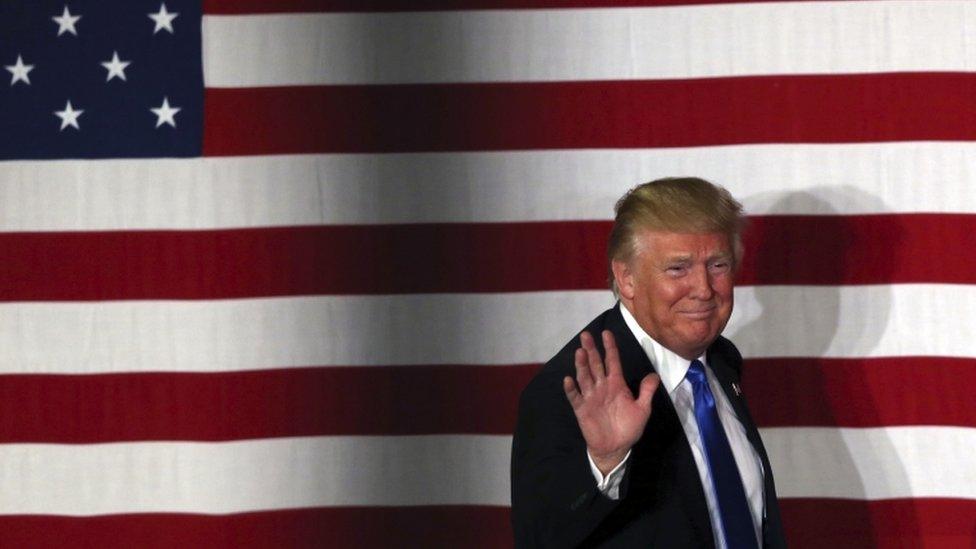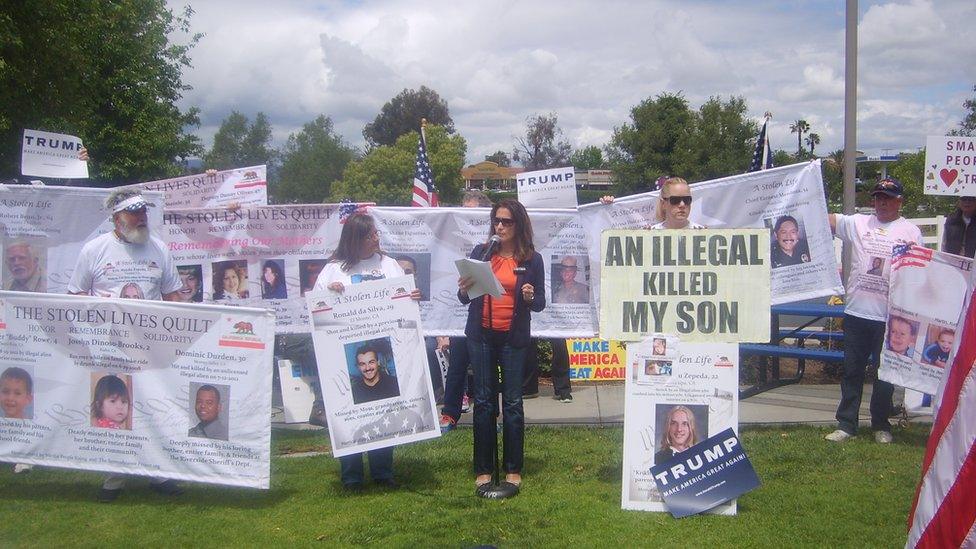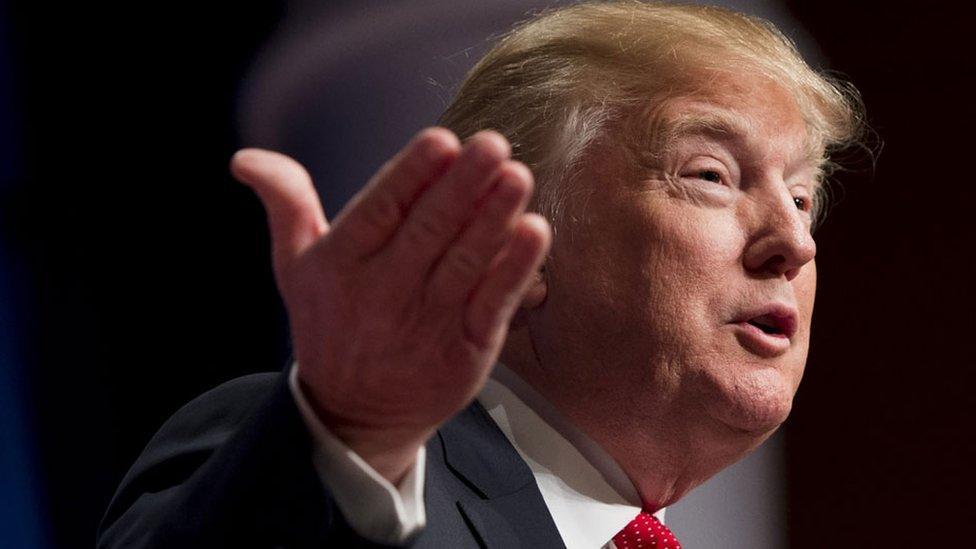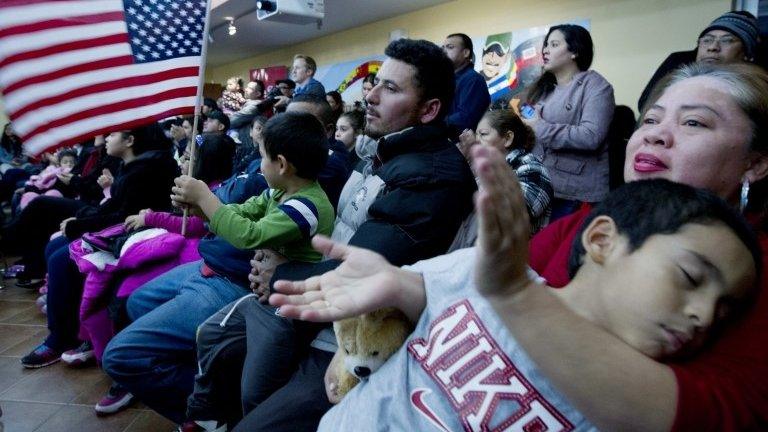Illegal immigration raises heat in US election
- Published
Border agents say Chinese and Indian people are among those claiming asylum on the US-Mexico border
The Mexican border is a line that sends an electric charge through the US presidential campaign.
Donald Trump has fixed on immigration as one of the causes of the tide of anger on which his campaign has risen.
If it's not the threat to American jobs from an influx of cheap skilled labour, it's the steady flow from Mexico, much of it illegal, that he says is unsustainable.
Hence his famous promise to build a 2000-mile wall, which has come to define his campaign.
He is right that this nation of immigrants struggles with the question, and his proposed "solution" has now turned it into a dividing line that will help to shape the autumn campaign.
There is a sour whiff in America of the European immigration debate: never before has it been used so deliberately to raise the political temperature.
Mr Trump knew what he was doing, and it has worked.
Donald Trump wants to deport every single illegal immigrant - could he?
Trump's foreign policy: So crazy it just might work?
Trump's immigration plan savaged by rivals
Why Mexicans are troubled by Donald Trump
'Illegal Mexican migrant killed my son'
But visit the border in southern California - where they say it is the busiest international crossing point in the world - and you witness the complexities, not the simplicities.
I stood looking through the fence with border agent Chris Harris, and he told me: "There's no silver bullet. No easy answer. A wall won't solve it."
I spent a few hours with him on his stretch of the border, about 20 miles south of San Diego.
He is an interesting witness - a Republican voter, who has worked all his life in law enforcement (he was a narcotics detective and then a prison officer in New York), the union representative for the border guards, who spends every day with his colleagues on the stretch of border running due east from the Pacific shore.

A ladder made by people smugglers to help illegal immigrants get over the border fences
When he arrived nearly 20 years ago, the border seemed hopelessly porous, with untold thousands of illegal immigrants crossing easily, slipping through the undergrowth, mounting elaborate deceptions to occupy the guards and bring whole parties over, squeezing through tunnels. That has changed.
Chris Harris still reckons that 5,000 (and probably more) get through each year on the short six-mile stretch where we're walking - but compared with the past, that is a trickle.
Across the rough terrain, roads have been built for patrols, navigable canyons blocked, and two fences built.
They are dotted with repairs where illegal immigrants have cut through, and we handled one of the metal ladders designed to be hooked over the top and get a few people over in a few seconds in the dark.
It is a cat-and-mouse game, constant and dangerous. And where many of the crossings in the past were by individuals desperate to find work, much of the traffic is now controlled by violent people-smuggling cartels who are running a big, nasty business.
The drama on the border can easily be used to make it sound like a simple problem of law enforcement, and right and wrong.
But there are problems apart from the fact that the agents believe a wall, however high, wouldn't be the answer.
Officially, there are more than 11 million "undocumented" (ie illegal) immigrants in the US, although the real figure is thought to be much higher.

Illegal immigration to the US:
There were 11.3 million unauthorised immigrants in the US in 2014, making up 3.5% of the US population
The number of unauthorised immigrants in the US peaked at 12.2 million in 2007
Mexicans made up 49% of all unauthorised immigrants in 2014, but their number has declined in recent years
Six states accounted for 60% of unauthorised immigrants - California, Texas, Florida, New York, New Jersey and Illinois
Unauthorised immigrants made up 5.1% of the US labour force in 2014
Source: Pew Research Center

Many have been there for years, working and raising families.
Those families have gone to school and college and are in the workforce, and there is a third and fourth generation.
What to do?
Mr Trump says send them home.
But many senior Republicans - John McCain and Mitt Romney, the two most recent presidential candidates, are obvious examples - want to find "a pathway for citizenship" for these people, because they want to be Americans.
It is that view that Donald Trump challenges, arguing the populist case.
But awkwardly for him, huge numbers of business through the southern states don't like the "send them back" message, for the simple reason that cheap labour, legal or not, keeps them going.
And Peter Nunez, a former federal prosecutor in California, who shares Mr Trump's view that immigration flows - legal and illegal - have to be stemmed, acknowledges that truth.

Donald Trump has made immigration a leading issue in the 2016 presidential race
There is another salient political fact: the Latino population that is registered to vote leans strongly to the Democrats.
Mr Nunez says there are future votes for them from mass immigration.
Meanwhile, the "undocumented" continue to work - you can see some of them on a dozen intersections each day in San Diego, selling themselves as day labourers - and don't go to the authorities to start the process of legal registration because they fear they would be sent home to Mexico.
The Mayor of San Diego, Kevin Faulconer, is one Republican who preaches consensus.
He says he wants to build a bridge and not a wall, and meets his civic counterpart in Tijuana, Mexico, every few weeks.

Campaigners on illegal immigration address a pro-Trump rally in California
It is not a border, he says, but a region where both sides have common interests.
It is no surprise that he hasn't been involved in the Trump campaign.
Voters, like the parties, are split on immigration, and Donald Trump has made sure that in this election these divisions are going to be as painful as he can make them.
- Published11 November 2015

- Published8 December 2015

- Published21 November 2014
